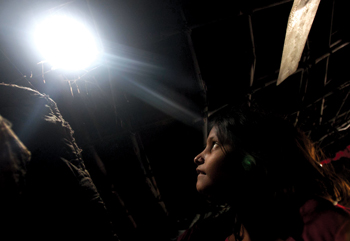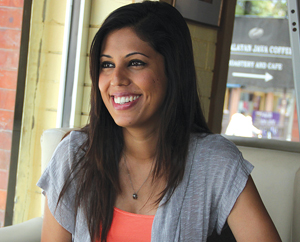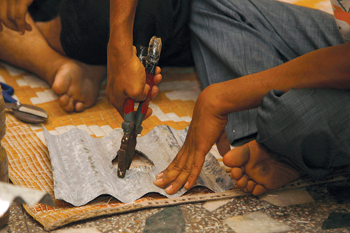A young public health graduate lights up villages in Tarai with bottles of water and bleach

SANJOG MANANDHAR
When 26-year-old Amudha Mishra (pic, below) learned about My Shelter Foundation’s ‘A litre of light’ project during one of her classes, her thoughts immediately turned to Nepal where large sections of the population still live in darkness. The technology developed by MIT students is not only simple, but environmentally friendly and affordable. Plastic bottles are filled with bleach, covered by metal sheets, and tucked into roofs. When sunlight hits the bottle, the water refracts the light and provides about as much illumination as a 55-watt light bulb (see box).
My Shelter first started installing these makeshift lights in 20 cities across the Philippines in 2002. Today the project has helped illuminate hundreds of homes of poor families in Argentina, Peru, Bangladesh, and India. Determined to replicate its success in her home country, Mishra, a public health graduate from the University of Colorado, began Ujyalo.
As a participant of Clinton Global Initiative (CGI) University in Missouri earlier this year, Mishra had the opportunity to network and learn from other young entrepreneurs as well as experts. While CGI provided her training in skills needed to run the project, money for Ujyalo was raised through donations online.

AMIR JOSHI
Mishra decided to base the pilot project in the Dom community of Birganj after Ujyalo’s baseline survey showed that majority of people in this area lived in dark, damp, windowless homes. “I know the
energy crisis in Nepal is too large to be solved by a few hundred bottle bulbs,” she admits. “But there are communities in Nepal that live in absolute darkness even during the day. We want to make their lives a little better.”
Once in Nepal, Mishra and her Ujyalo team partnered with Sano Paila a local NGO which works on improving health, sanitation, and social infrastructure in the district. But even before they could begin, they discovered a shortage of used soda bottles in the villages as people there rarely consume soft drinks. The team had to switch to using mineral water bottles, which aren’t as sturdy as soda bottles, but still last for three to five years depending on how well they are looked after.
Convincing people to open their homes was the next challenge. “In the beginning locals were not convinced how a bottle of water and bleach could light up their homes. And they were naturally hesitant to let in strangers to make holes on their roofs. But after a few demonstrations, I think they realised how useful the makeshift lights could be and slowly began warming up to the idea,” explains Mishra.
Within three weeks in June, Ujyalo and Sano Paila installed 130 lights in three wards of Birganj. To give locals a sense of ownership and involvement in the project, a carpenter from the community was hired and trained to fix bulbs on rooftops and help with the long-term maintenance of bottles. Home-owners for their part will have to clean the bottles regularly and replace them every three or four years.
Says Mishra, “Ujyalo is not just about providing light. It’s about training locals in new techniques so that they can generate sustainable energy at the grassroots level even with limited resources. They don’t have to wait for years for the government’s million dollar projects to come through.”
Mishra who is currently in the US will return to Birganj in October for a follow up. She hopes to expand Ujyalo’s reach into other districts in the coming year and wants to turn her small project into a lifelong endeavour to light up more Nepali homes.
www.ujyaloinnepal.wordpress.com
www.sanopaila.org.np
www.aliteroflight.org
Make your own sunshine

SANJOG MANANDHAR
The idea is simple. Generate 55 watts of light using cheap, durable, and readily available materials. Although, the energy can’t be stored for use at night, this sustainable technology has helped light many poor communities around the world during the day.
What you need
1.5 litre pet soda bottle
Galvanised iron (GI) or steel sheet
Rubber sealant
Bleach
Filtered water
How it’s done
Step 1: Add 10ml of bleach to a soda bottle filled with distilled water.
Step 2: Cut approximately 9x10 inches of GI sheet and draw two circles at the centre. Cut a hole out of the inner circle.
Step 3: Cut the 1cm difference radially from the second circle, making strips. Bend the strips upwards, perpendicular to the sheet.
Step 4: Insert the bottle into the GI sheet. Apply rubber sealant on the strips above and around the area below to protect the bottle from falling. Let it dry.
Step 5: Cut a hole in the roof with a circumference similar to the bottle’s.
Step 6: Place the bottle into the hole.
Step 7: Drill four nails on each corner of the bottle bulb.
Step 8: Apply rubber sealage around the edges of the sheet of the bottle to avoid leakage.
Step 9: Place a protective plastic tube on the bottle cap and apply rubber sealant.
A Litre of Light video
Lighting up the Tarai